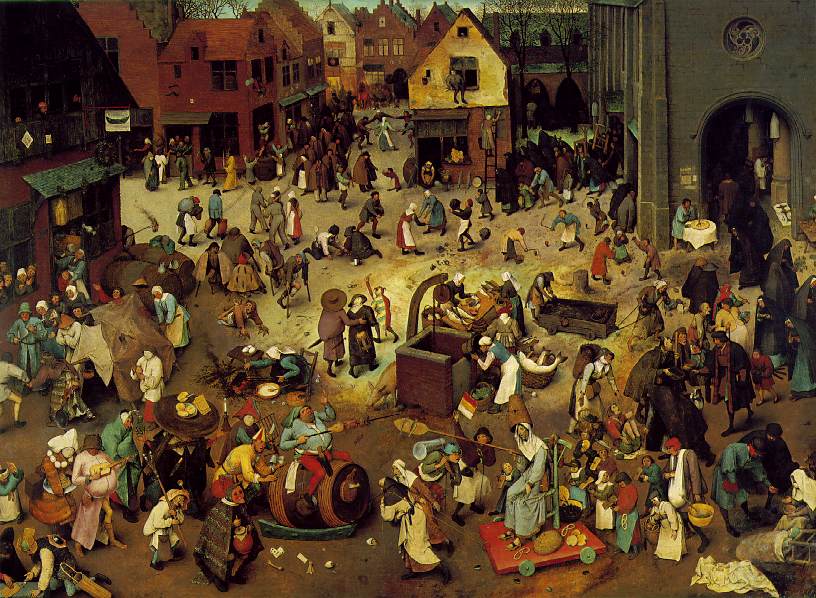March 18, 2005
noise and music
I'm reading Jacques Attali's Noise: The Political Economy of Music, which was originally published in French in 1977. We previously mentioned the text here.
From a brief glance the book is a criticism of the modernist understanding of music as autonomous and unrelated to the turbulent political, social and economic world in which it is composed and performed.
He argues that music expresses changes that are only manifest latter in our culture; music is a harbinger of change, an anticipatory abstraction of the shape of things to come.

Brueghel the Elder, Carnival's Quarrel with Lent
Attali thinks that this painting represents his own ideas about music, noise, and politics. If we draw a line from the upper left corner to the lower right corner, the painting divides into two "zones." Carnival is the left zone. Lent is the right zone. These zones represent two antagonistic cultural and ideological modes of organization. Attali pits noise (i.e., discord, revolution, freedom) against harmony (i.e., order, regulation, constraint)---'tis a reworking of Nietzsche's Dionysian and Appollonian modes of life.
The theis is that an outside noise intrudes on the existing order of harmony; eventually, he says, those noises that persist are absorbed into the harmony, creating a new harmony that will have to try to hold its own against some unknown noise of the future. The sobriety of Lent will always be countered by a joyous Carnival, Attali says, and where the two modes of behavior meet there will always be Quarrel.
His political economy of music is structure around four successive codes or modes:
- Sacrifice: the ritual code based on fear, when violence is channelled into acceptable rituals binding the group in which music had a "use value" outside exchange.
-Representation: the code based on exchange and harmony in which music became an object of exchange. The greater professionalization demanded a greater separation between performer and audience, which necessitated the beginning of musical exchange value as musicians began working for patrons and royalty.
-Repetition: the age of sign exchange, dominated by a "speech without
response" and a code of normality in which music became a part of mass production and consumption as industrial revolution took hold. Music become a strategic consumption under the control of corporate music industry. The musical work is now wholly commodified is capable of being stockpiled for future listening and, as a commodity, it is removed from the musical workmanship that created it.
-Composition: the future possibility of passing beyond sign exchange into a new community in which music is basically about improvisation. As a musical code composition is a return to personal usage and meaning in music, an escape from the economic and political structures that have arisen around music the previous 500 years.This mode is indicated by the new compositional and performing styles and philosophies of John Cage and the free jazz artists of the 1960s and in the noise manifestoes and instruments of Luigi Russolo.
These four historical stages of music production, each of which creates a particular relationship, or network, between individuals and their social organizations.